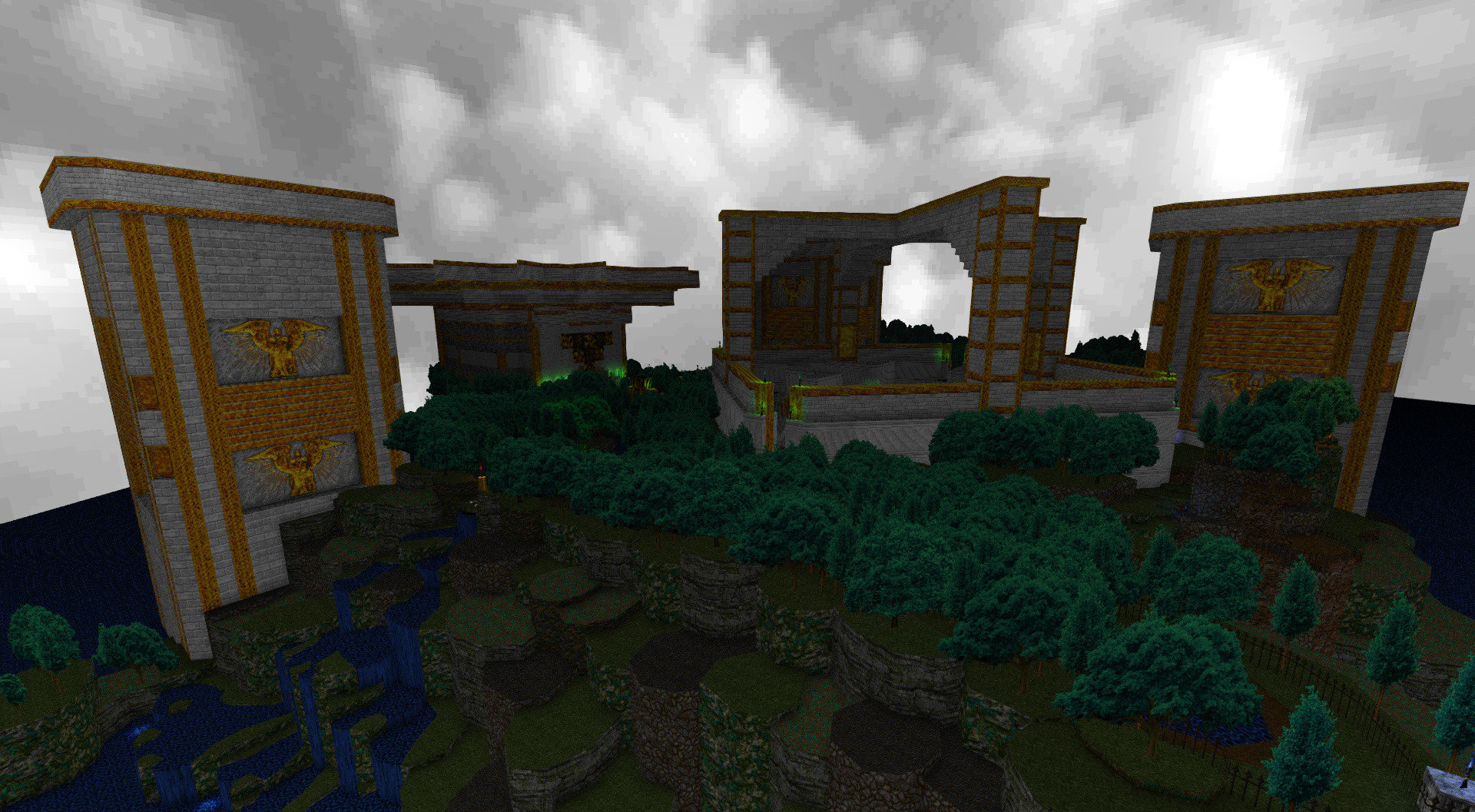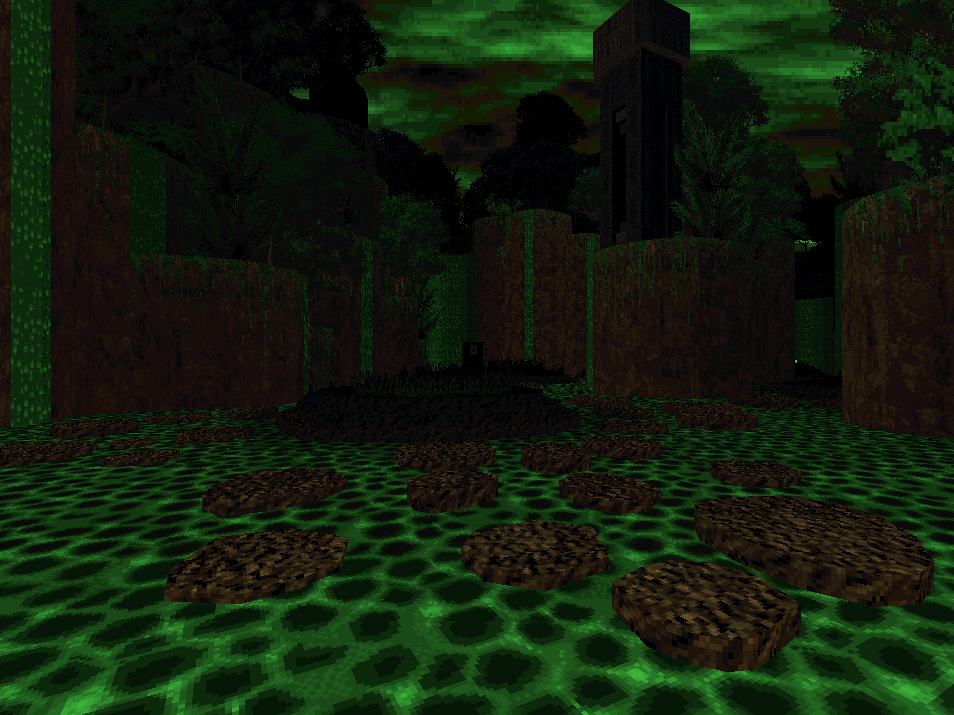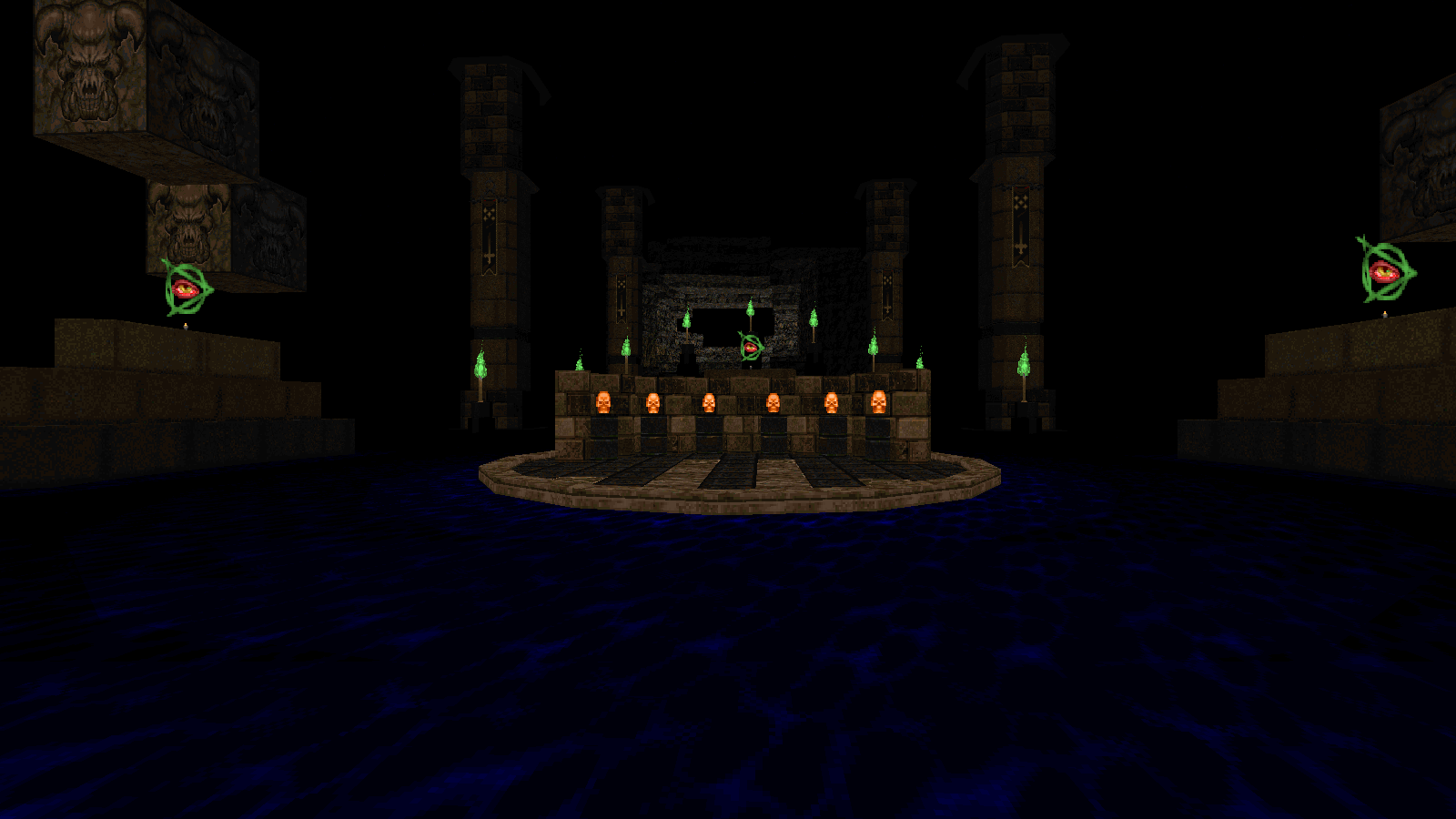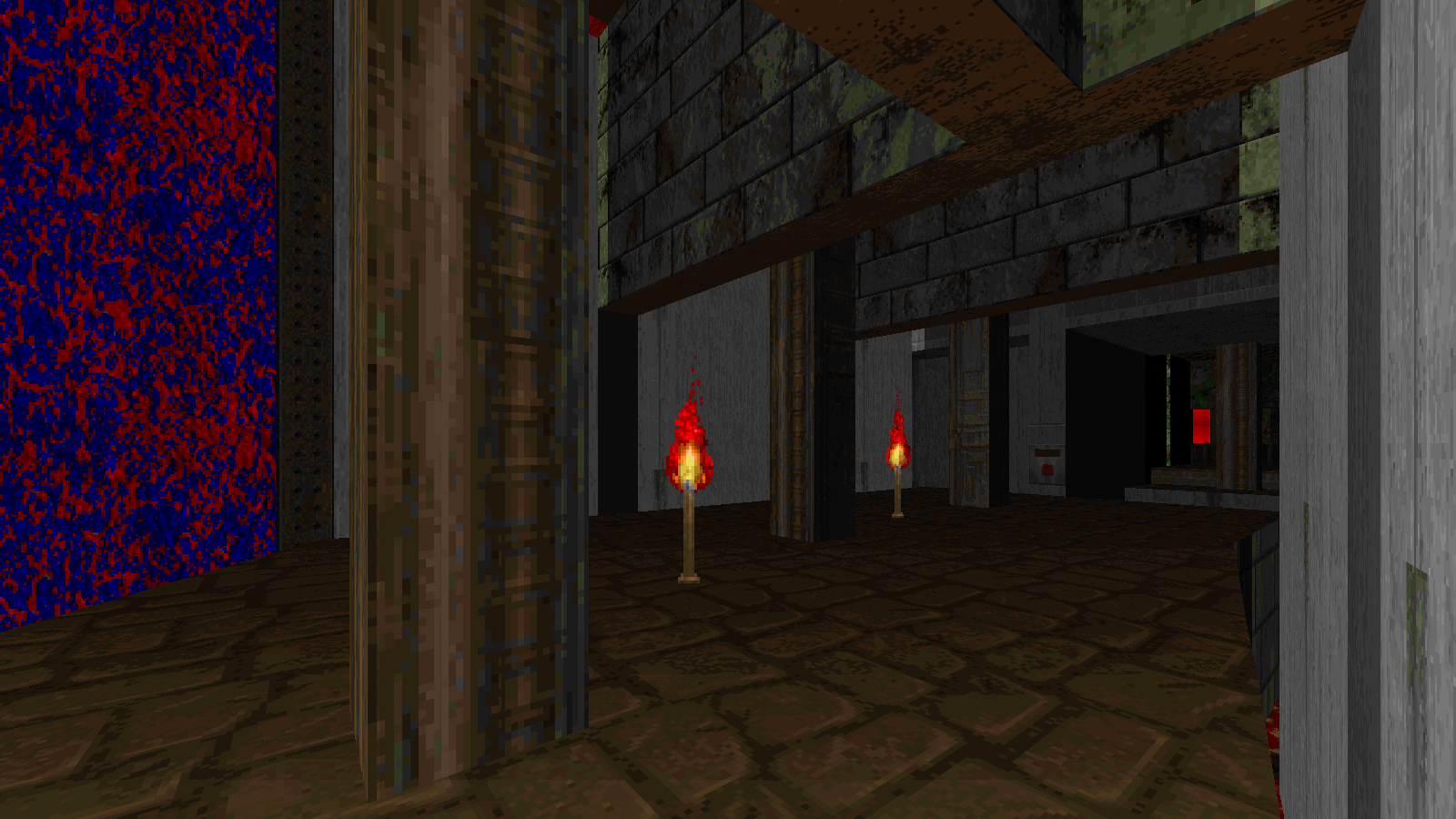-
 Eviternity - @Dragonfly et al
Eviternity - @Dragonfly et al
Doom 2, Boom-compatible, 32 maps
An epic journey from Earth to hell and beyond, Eviternity astounds with grandiose architecture and lush, stunning environments. Set far enough in reality to feel grounded, but with enough fantastical elements to instill wonder (and sometimes terror), Dragonfly and co. have created an experience that simply should not be missed by any Doomer worth their salt.
The breadth of styles presented in this megawad brings something for everyone to the table, while still remaining completely cohesive. Dragonfly’s sheer flexibility in mapping is strongly evident with each episode, growing more abstract but staying a steady course of quality that is exemplary from beginning to end. From brutalist concrete complexes to hellish spaces lined with brimstone and gore and a sprawling gold-gated Elysium, players can expect to find themselves someplace brand new with each map, each encounter more visceral and surprising than the next. The guest mappers pull no punches either, chipping in with their talent to bring Eviternity to the next level. Cryonology by @AtroNx chases you through ice-lined halls to a monstrous arena, a clock striking the thirteenth hour. Watch out—there’s a few surprises waiting for you there. Elysium, co-created by Dragonfly and @Eris Falling, features a delicately corrupted landscape that you’ll want to fly over to take in (spoilers: you actually can!). And then, there’s Anagnorisis. Created by @ukiro, this brutalist, labyrinthian epic brings a fearsome challenge with its scale, puzzle elements, and combat that can go from simply rough-and-tumble to visceral in the blink of an eye. But perhaps one of the most interesting things about Eviternity is its end. Your ticket into heaven comes at a price, but its guardian is not some demonic leviathan. In fact, it’s a vengeful archangel, summoning hordes of demons to aid in your defeat.
The amount of care taken into crafting Eviternity is evident in more than just its maps—its music and its textures elevate the playing experience to a whole new level. Eviternity’s MIDI-ogrophy features pieces from high-caliber artists such as @stewboy, Eris Falling, @Alfonzo, @AD_79, and, of course, @Jimmy. Perhaps one of the most notable pieces is Jimmy’s “Ghostgrinder,” a bright, progressive melody with a driving beat that keeps pace with map 24, Gossamer by @Mechadon. Eris Falling’s “Eviternity” creates a dark yet soaring backdrop to the final battle, bringing through feelings of both despair and haunted elation.
Eviternity is also one of the first notable uses of ukiro’s high-quality texture pack, OTEX. The breadth of aesthetics and environments in Eviternity is testament to the texture pack’s range of usefulness. The other unique aesthetic note of Eviternity is its unique palette, turning the green range into an almost aethereal teal, so dubbed “Eviterniteal” by its creators.
All in all, Eviternity is, without a doubt, a masterpiece that’s combined the best of classical Doom combat and modern design, creating an absolute joy of a playing experience—one that you’ll want to play forever.
Doom 2, GZDoom, 1 map
Nestled onto a lush green island surrounded by a shimmering ocean, this behemoth stone fortress stretches to the ominous star-filled skies, oozing with demons and mystery. Aiming to make something “non-linear,” exl does that and much more, mastering exploratory gameplay while simultaneously giving the player a lot of ass to kick. Your mission is simple: gather four keys and make your way to the dock that you see on the other side of the island in order to leave. However, this task is anything but easy.

The fortress itself is essentially a tri-level, each floor holding a unique set of encounters and challenges. Exl uses space well both vertically and horizontally, this being most evident in the middle floor. You’re peppered from above every now and again by the odd imp, shotgunner, or revenant, just enough to keep you on your toes and keep you looking for the next place to go. This map is absolutely teeming with secrets—it’s wise to explore every nook and cranny for valuable health, ammo, and armor. You’ll need it for the battles ahead. The use of sloping and 3D techniques are done in a realistic and practical way, never feeling superfluous or self-indulgent. Every linedef seems to have purpose here.As you weave your way through, the encounters get slowly more difficult, but the progression is completely smooth and natural, so much so that it’s nearly undetectable to the average player. Though incidental combat may not sound so exciting, exl makes it feel natural and fresh, placing monsters in patrols that are perfect for keeping you engaged as you roam the stone halls. One of the more notable fights is the one down by the shoreline after navigating a particularly tough set of sewers. After picking up yet another key, you’re faced with a much larger horde of enemies, including an angry cyberdemon, chasing you back through the sewers and leaving you hoping you’ll get out alive.
Once you complete the task of navigating through the fortress and gathering the keys, what comes next can only be described as a very tense descent. As the elevator you step onto descends, each stop brings you to a floor of surprises, many of them nasty. Keep your head, though, and you’ll come to your escape from this hellish place. One can only wonder though, as you pick up the armor from someone so close to making it out—is this the end of the journey…or only the beginning?
Doom 2, GZDoom, 7 maps
Every year has patterns emerge that retroactively describe much of its output. 2017 was a stock-texture resurgence, headed by Counterattack, No End in Sight, and Saturnine Chapel. 2018 provided high activity in the "AAA total conversion" category, with REKKR, The Adventures of Square e2, and The Golden Souls 2. This year, with Paradise, Hell-Forged, and The Wayfarer, the party crashers are 2-in-1 offerings: ambitious mapsets with dedicated gameplay mods, designed in a sort of symbiosis, map informing mod and vice versa, the whole much greater than the sum of its parts.
Paradise is Tango's first big thing since 2014's acclaimed Mayan Mishap. Where Mayan Mishap trekked several paces past Doom 2's stock behavior, Paradise emerged in a different world entirely. Weapons, mostly new, need to be reloaded. Damage from player and foe alike is normalized, freed from the usual vagaries of RNG. The altered bestiary, though largely recognizable, assails the player with an array of new projectile patterns, exotic area-denial attacks, and other fancy surprises.
While none of these changes are truly outlandish to a well-traveled Z-ologist, the context is rare. Historically, gameplay mods have focused more on fleshing out an artistic concept, on infusing novelty into the norm—essentially, on sandboxy fun for its own sake. Tango's vision, however, is about proficiency. Paradise's tougher levels are outfitted with arena combat that echoes Sunlust or Resurgence: clever designs, with intensity to match. In spaces geared to thwarting mindless circling, the higher difficulties extend your grasp of the new meta, and, just as relentlessly, demand that it stay firm.
Viewed from the reverse angle, gameplay of this sort has traditionally relied on the tried and true stock mechanics and their associated trove of communal wisdom. The risk of drastic modding is that precedent no longer guides the author on the right track, just when being on that right track matters most; when tight setups are howling for the player's blood left and right, trifles become nuisances, hitches become showstoppers. Intimately aware of this risk, Tango went for an unusually fussy public testing cycle: a double-digit number of beta versions, substantial changes throughout, nearly all of the original maps swapped out for better replacements by the end. And in the end, we can say resoundingly that he pulled through, with a smooth and rewarding experience you can just about sink into, like so many bogs and spring pools.
Behind the bloodshed is a lush backdrop that tells the story of the Earth's rebellion. At first, the title is very much apt; we're treated to sunny skies, clear water, and smooth ground you wouldn't mind walking on barefoot. But if we learned anything from two decades plus of Doom, it's that tech complexes, whether anonymous or under the banner of UAC, were always up to no good before the humans vanished. The title takes a melancholic, sarcasm-laden twist. As the day ends, the sky bleeds emerald, and the world has grown toxic, installing a big question mark between present and future. Through this internal narrative, Paradise suggests that the Scythe 2 chapter format, known for its visual unity, is full of undiscovered life, unexplored paths for varying the formula while retaining the traditional framework. The finer nuances of presentation too leave a strong mark: the crisp ambient sounds, like shell casings rattling on ground; the snazzy frills and effects, like baddies exploding in chunks after a devastating blow; and the impeccable sprites, like the scaly, alienoid takes on the revenant and others, crafted by community treasure Amuscaria.
As a final note, if the talk of tough encounters was terrifying, the first two skill settings offer run 'n' gun action while taking a nerf cannon to the hardest, most slaughter-oriented fights. "Tough," the UV analogue, ramps up the challenge higher than most modern mapsets, which around the third map becomes unmistakable. "Extreme," the highest setting, is like UV+(+), rather than Nightmare. If it's for you, you'll know.
- @rd.






